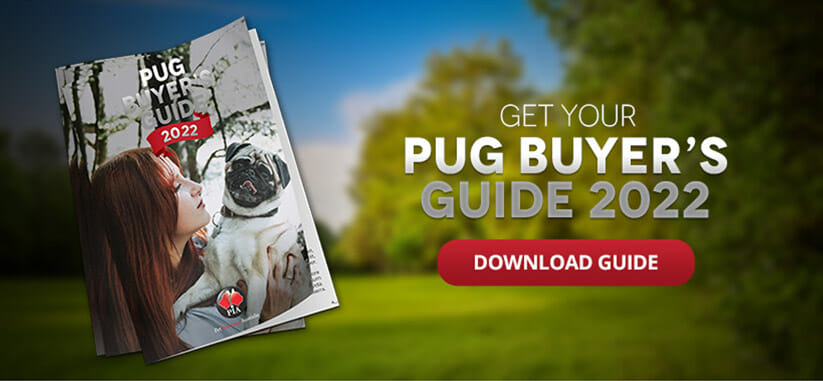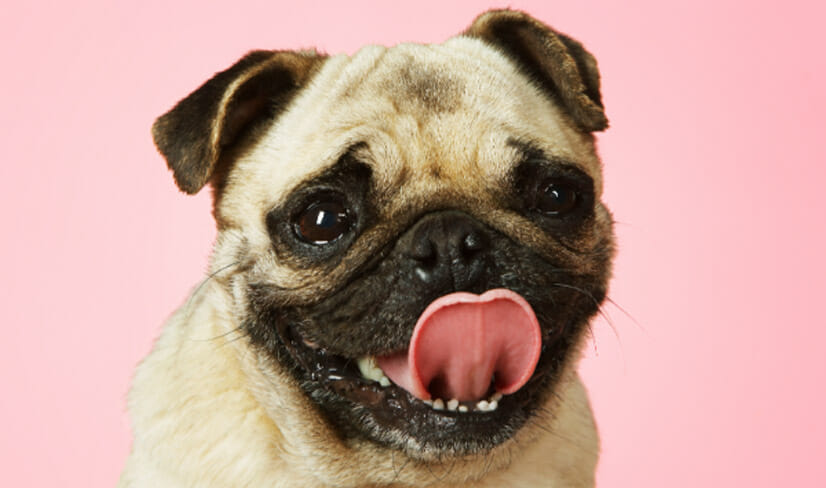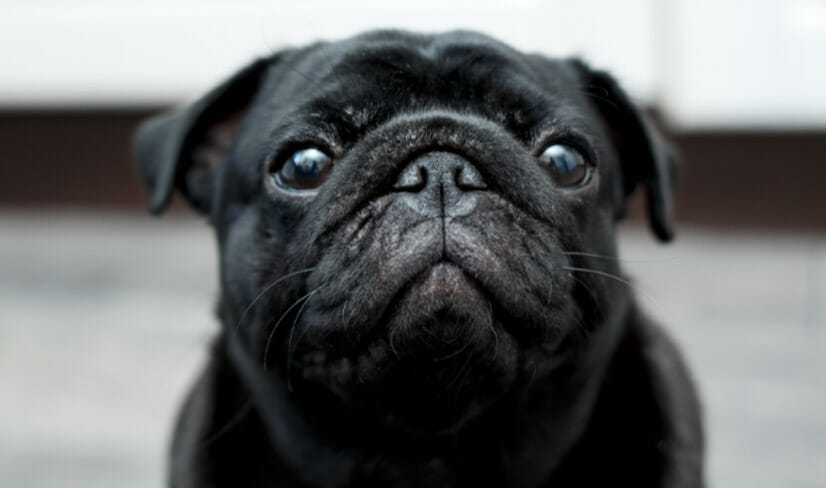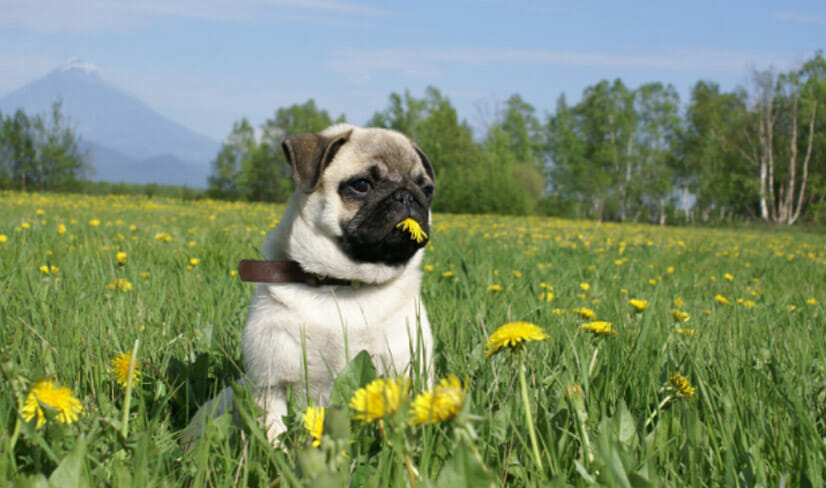Pug Dog Breed
andreas strauss
June 15, 2022
Pugs are one of the most renowned toy-dog breeds in the world! Best known for their unique appearance, stocky bodies, and tendency to show off, these pups are the definition of dynamite in a small package. In this article, we’re going to break down the basics of the Pug and help you decide if this is the right dog for you.
Quick Links:
- Pug Characteristics
- Pug Origin
- Pug Personality
- Pug Appearance
- Adopting a Pug
- How much does a Pug Cost?
- Pug FAQs
- Additional Resources on Pugs
If you’d like to learn more about the Pug, please watch the video below!
PUG CHARACTERISTICS
| Life Span: 12-15 Years | Grooming: Easy | Child Friendly: Yes | Tendency to Bark: Low |
| Health Issues: High | Shedding Level: High | Apartment Friendly: Yes | Tendency to Drool: Medium |
| Energy Level: Medium | Adaptability: Moderate | Pet Friendly: Yes | Tendency to Chew: Low |
| Exercise Needs: Medium – Up to an hour a day | Social Needs: High | Affection Level: High | Trainability: Medium |
PUG ORIGIN
The Pug dog’s origin can be traced back to the Han dynasty in China! Since the very beginning, Pugs have been dogs that live in the lap of luxury as they were prized by Emperors throughout China’s history. They’re even thought to be related to the Tibetan Mastiff, another highly regarded East-Asian dog.
Here are some fast facts about the Pug’s history:
- Pugs weren’t just favoured by Chinese emperors. Throughout their history in Europe, they were the preferred dogs of various Royal lines and noble houses.
- Pugs were so adored by their noble owners that sometimes imperial soldiers would guard them in their luxurious accommodations.
- Pugs are one of three ‘short-nosed’ dogs to have been bred in China, next to the Pekingese and the Lo-sze (which was considered to be an ancient variant of the Pug).
- Historical records suggest that Pugs were introduced to the Western world, specifically Europe, in the early 1600s.
- Pugs were originally very popular upon their introduction to America in the 19th century, however, their popularity quickly faded and only a few organisations continued to breed them exclusively.

PUG PERSONALITY
Unlike many other breeds of dogs, Pugs were developed for the sole purpose of companionship – and it’s what they do best! Pugs are known to vie for the attention of their owners and find their bliss by sitting comfortably in the laps of humans who adore them.
Here are some of the key temperament traits of Pugs:
- Pugs are pros at chilling. These dogs are sedentary in their nature, and they have a strong preference for lounging about the house whenever they can. Although, they do tend to be at their happiest when lounging on a human’s lap.
- They’re highly affectionate dogs. Pugs were bred to be social and engage in frequent human contact. Due to this, they require constant attention from their owners and struggle to be left alone for even short periods of time.
- They’re quite curious little pups. A healthy Pug is a curious Pug. These dogs love to be involved in anything and everything that their humans do, and enjoy checking out the scene when it comes to other household pets.
- Pugs have a sweet, silly sense of humour. Pugs love to entertain! They’re often known to perform adorable antics that make their owners laugh and keep up a lively attitude in the home.
PUG APPEARANCE
Pugs aren’t just unique in their temperament. These dogs have a distinguished and easily identifiable look that resonates heavily with fans and pug-lovers. Their ‘squished’ faces, small little bodies, and curly tails are just a few of this breed’s well-known characteristics.
Here’s a quick run-through of the Pug’s defining features:
- Flat muzzles – All Pug puppies are born with short, flat muzzles with tiny black noses and wide mouths.
- Roundhead – Pugs have round-shaped heads and full cheeks.
- Long tongues – All dogs have pretty long tongues, but when Pugs let theirs hang out, they almost seem comically longer than most!
- Folded ears – Pugs naturally have small ears which fold over at the tips. This type of structure is often referred to as a ‘rose’ ear.
Pug coat colours are known to come in:
- Fawn
- Black
- White
- Brindle
- Blue
- Merle
- Chocolate
- Black and Tan
- Pink
- Pied
- Platinum
The AKC (American Kennel Club) only recognise black and fawn-coloured pugs as purebreds. You can read more about the Pug’s different coat colours here.
ADOPTING A PUG
When it comes to looking at Pug puppies for sale, it’s important to remember that there are a few key factors to refer to in order to ensure that you adopt a healthy puppy. When looking for Pug Breeders in Australia, make sure to keep an eye out for:
- Breeders with trusted reviews and extensive history with the specific dog breed that you’re looking to adopt.
- Breeders who don’t offer low prices. Breeders who charge a higher fee, rather than ‘cheap deals’ are often more likely to breed puppies with more care and purpose than those who do not.
- Breeders who aren’t just experts on this breed, but have a passion for it too.
- Breeders who encourage you to meet one or both of the parent dogs of your puppy. This is a great way to get an idea of the personality that your pup may have, along with any potential hereditary health conditions that may pose a problem.
- Ask around for recommendations from vets and other dog professionals, these are the first people you should go to when on the hunt for a good breeder.
Use this guide as a ‘checklist’ when it comes to what to look for in a reliable breeder.
In the event that you don’t wish to work through a breeder, you may want to visit an animal shelter when adopting a Pug. Although shelters are usually made up of dogs past their ‘prime’, and purebreds aren’t plentiful, there are actually a variety of Pug rescue associations across the country. You should think about adopting through a shelter or rescue when:
- Looking for an older dog. Adult Pugs or even older dogs have fully grown and developed into their personalities and are usually already house-trained, so they can adapt to their new homes with more ease than their younger counterparts would.
- Looking to give a dog a new life. There are plenty of unique, loving Pugs waiting for a new home and a new family. If you’re not set on a specific type or variant of Pug, then we would suggest looking at this option.
You can browse a popular Pug shelter here, and other dog rescue programs here.
HOW MUCH DO PUGS COST?
Pug puppy prices, as well as Pug adult dog prices, can range from anything between $800-$1,500. This is all dependent on the breeder as well as the parent Pugs.
PUG FAQS
Are Pugs good dogs?
Yes, they are! Pugs were bred for human interaction and thus, have been known to make excellent family dogs. Pugs are also extremely good with children and other household pets!
What are Pugs known for?
Pugs are most typically known for their unique, stand-out appearances. However, they’re also known for their fun-loving and gentle personalities as well as the ease with which they are able to socialise with people and other animals.
Do Pugs bite?
Aside from the fact that this breed is known to be very docile – Pugs actually aren’t able to bite efficiently. This is due to the shape and structure of their mouths. Regardless, they aren’t vicious or aggressive dogs, and the most they’re likely to do is slobber all over you.
- Pug paws and how adorable they are – as well as how to care for them properly.
- Chinese dog breeds that you probably didn’t know were bred in China!
- Wrinkly dog breeds, they’re more popular than you’d think!
- Cute dog breeds, even though every dog is cute, these ones are on a whole other level of ‘aww’.
- Black Pugs, are the most sought after pups.
- Facts about Pugs that you definitely didn’t know about!
- Baby Pugs and why they’ll melt your heart.
- Pugs as pets and why they’d make wonderful additions to your family!
Remember, you should always do considerable amounts of research before choosing to adopt a dog. Adopting a new pup is a big responsibility, and you should always be prepared! You can read through a full, comprehensive guide on Pugs here if you’re interested in learning more about this breed.
If you do end up adopting a Pug, Pet Insurance Australia is the perfect place to get your dog insurance sorted! Contact us today for a quote, and we’ll look out for your furry friend, too.
disclaimer
This blog does not replace a qualified veterinarian’s medical expertise or advice. Please consult a registered veterinarian for further information on the blog topic. The material and information on this blog are for information purposes only. Please note that any linked websites or mentioned products are not sponsored affiliate links or paid endorsements. Pet Insurance Australia does not accept liability for any damages arising from your interpretation of the information presented on this blog. This includes Pet Insurance Australia not being liable for: any false, inaccurate or incomplete information on the blog; any damages that arise from technical issues on the website and the blog being unavailable; any damages from clicking through a link in the blog to a different website.





8 Comment